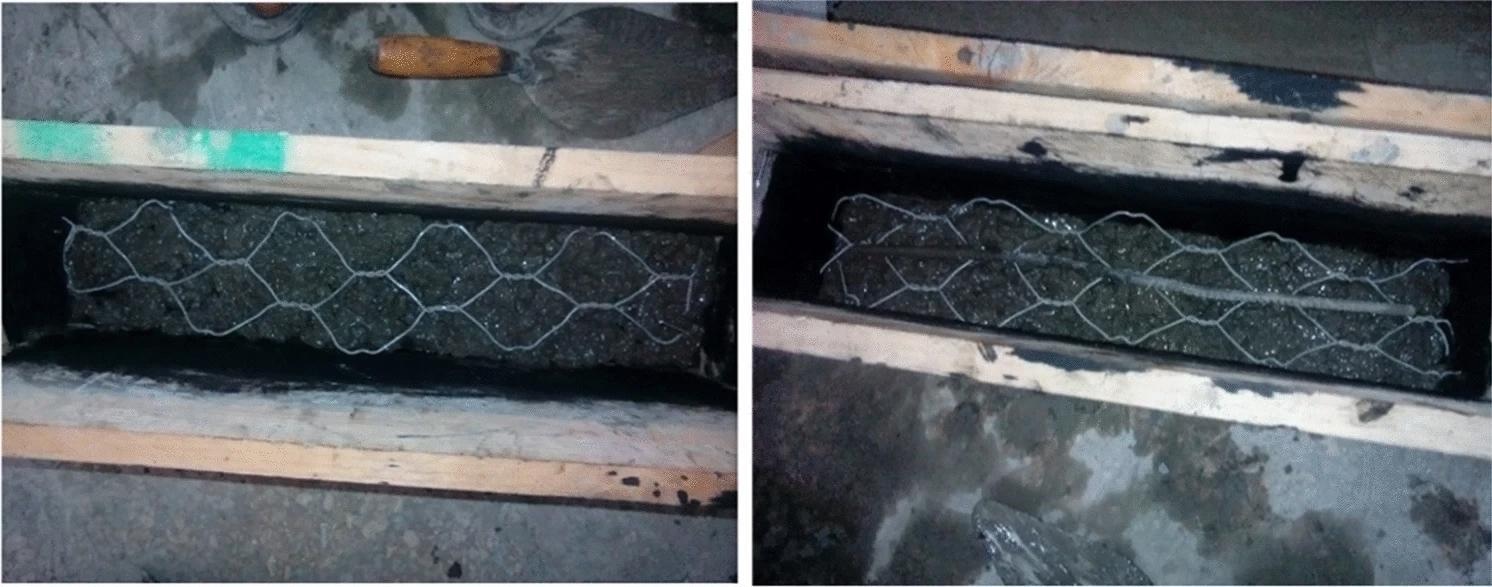 By Nidhi DhullReviewed by Susha Cheriyedath, M.Sc.Apr 29 2024
By Nidhi DhullReviewed by Susha Cheriyedath, M.Sc.Apr 29 2024A recent article published in Scientific Reports compared three eco-friendly wire mesh configurations to enhance the sustainability of reinforced concrete structures. Different layers and orientations of the steel wire meshes were used to evaluate the impact on the mechanical properties of reinforced lightweight aggregate concrete (LWAC).
 Casting of ferroconcrete beam model using hexagonal (chicken) wire mesh. Image Credit: https://www.nature.com/articles/s41598-024-59050-2
Casting of ferroconcrete beam model using hexagonal (chicken) wire mesh. Image Credit: https://www.nature.com/articles/s41598-024-59050-2
Background
Concrete consumes substantial natural resources, including cement and aggregates, but environmental concerns are driving the use of waste materials as substitutes. While plain concrete exhibits low tensile strength, high porosity, and limited crack resistance, the numerous advantages of conventional concrete—such as its versatility, strength under heavy loads, fire resistance, and durability in harsh weather—should not be overlooked.
Ferrocement has been proposed as a suitable solution to these problems in the construction industry. It is a thin wall-reinforced concrete structure commonly constructed using hydraulic cement mortar reinforced by small-sized wire mesh. The wire mesh reinforcement enhances the cement’s strength and durability and allows the use of waste materials in the concrete.
Most previous ferrocement-related studies focus on using waste materials to reduce the use of natural resources, enhance strength parameters, and promote a green and sustainable environment. However, limited research has been conducted on the mechanical properties and energy absorption of ferrocement by using different layers of several wire meshes in LWAC.
Methods
This study used three types of steel wire mesh (hexagonal or chicken, welded square, and expanded metal mesh) in LWAC. The impact of the different number of layers and orientations of the wire meshes was investigated on the LWAC’s mechanical properties including energy absorption (EA), compressive strength (CS), and flexural strength (FS).
After a thorough examination of the physical and chemical properties of each raw material, a total of 90 prisms and 33 cubes were cast for 14 days of curing. This large number of ferrocement specimens was statistically essential to draw accurate conclusions and make reliable predictions.
For the FS test, forty-five 100 × 100 × 500 mm prisms were cast in specially made timber molds using the three mesh reinforcements in four different setups. Alternatively, for CS tests, thirty-three 150 × 150 × 150 mm cube samples were made in readily available molds. The FS and CS tests were performed on a universal compression machine with an ultimate loading capacity of 1000 kN. Furthermore, a total of forty-five 400 × 300 × 75 mm slabs reinforced with different types of mesh and number of layers were prepared for EA tests.
A 3.028 kg cylindrical steel alloy was then dropped from a 1.0 m height on the top of each slab specimen. Subsequently, the number of blows was recorded at the instant where the first crack was observed and at ultimate failure (total collapse of the structure).
Results
The FS test results show that the FS of the reinforced concrete increased with the increase in the number of wire mesh layers added. One layer of chicken, welded, and expanded metal mesh enhanced the FS by 52.96 %, 23.76 %, and 22.2 %, respectively. Additionally, the average increment in the flexural capacity of the beam was 280.58 %, 197.9 %, and 123.55 % by chicken, welded, and expanded metal mesh layers, respectively.
The CS of concrete with LWAC gradually decreased as the number of layers of welded, expanded, and hexagonal wire mesh increased and was estimated to be 29.79 MPa when all three types of meshes were combined. The CS was estimated to be 29.79 MPa when all three types of meshes were used together. This reduction in CS of plain concrete can be attributed to structural cracks caused by weak bonds between the mesh and concrete, as well as significant buckling of the steel wire meshes.
In the EA tests, the amount of energy needed to crack or break the specimen was determined by the number of blows. In the combination of three layers, the chicken and expanded wire mesh had the maximum energy (1425.6 and 1108.7 J, respectively) before the final failure, while the welded square mesh had an energy maximum of 752.3 J. The energy absorption for the first layer with hexagonal wire mesh increased by 82.81 % before the crack and by 88.34 % before the ultimate failure.
Conclusion
For all three types of mesh, the EA capacity increased with the increasing number of layers. Alternatively, the CS decreased due to interfacial bonding, aggregate segregation, increased porosity, mesh interaction, reduced cementitious content, cracks, and fracture paths. However, the failure mechanism in all three tests was a ductile failure (large number of cracks but low width), which enhances the reinforced-concrete performance through improved crack control, energy absorption, durability, structural redundancy, and repairability.
Overall, the incorporation of wire mesh layers as reinforcement markedly improves the flexural strength, cracking behavior, and energy absorption capabilities of reinforced concrete. Among the types tested, chicken wire mesh was found to be the most effective due to its superior yield and tensile strength. Consequently, the researchers recommend further exploration into the use of chicken wire mesh in ferrocement structures. It is essential to address the key technical, economic, and regulatory considerations to facilitate its broader adoption in practical construction projects
Journal Reference
Mebrahtom, M., Fissha, Y., Ali, M., Gebretsadik, A., Kide, Y., Nguse, Z., Gebrehiwot, Z., Flores, E.S., Avudaiappan, S., & Ikeda, H. (2024). Comparative study of eco-friendly wire mesh configurations to enhance sustainability in reinforced concrete structures. Scientific Reports, 14(1). https://doi.org/10.1038/s41598-024-59050-2, https://www.nature.com/articles/s41598-024-59050-2
Disclaimer: The views expressed here are those of the author expressed in their private capacity and do not necessarily represent the views of AZoM.com Limited T/A AZoNetwork the owner and operator of this website. This disclaimer forms part of the Terms and conditions of use of this website.